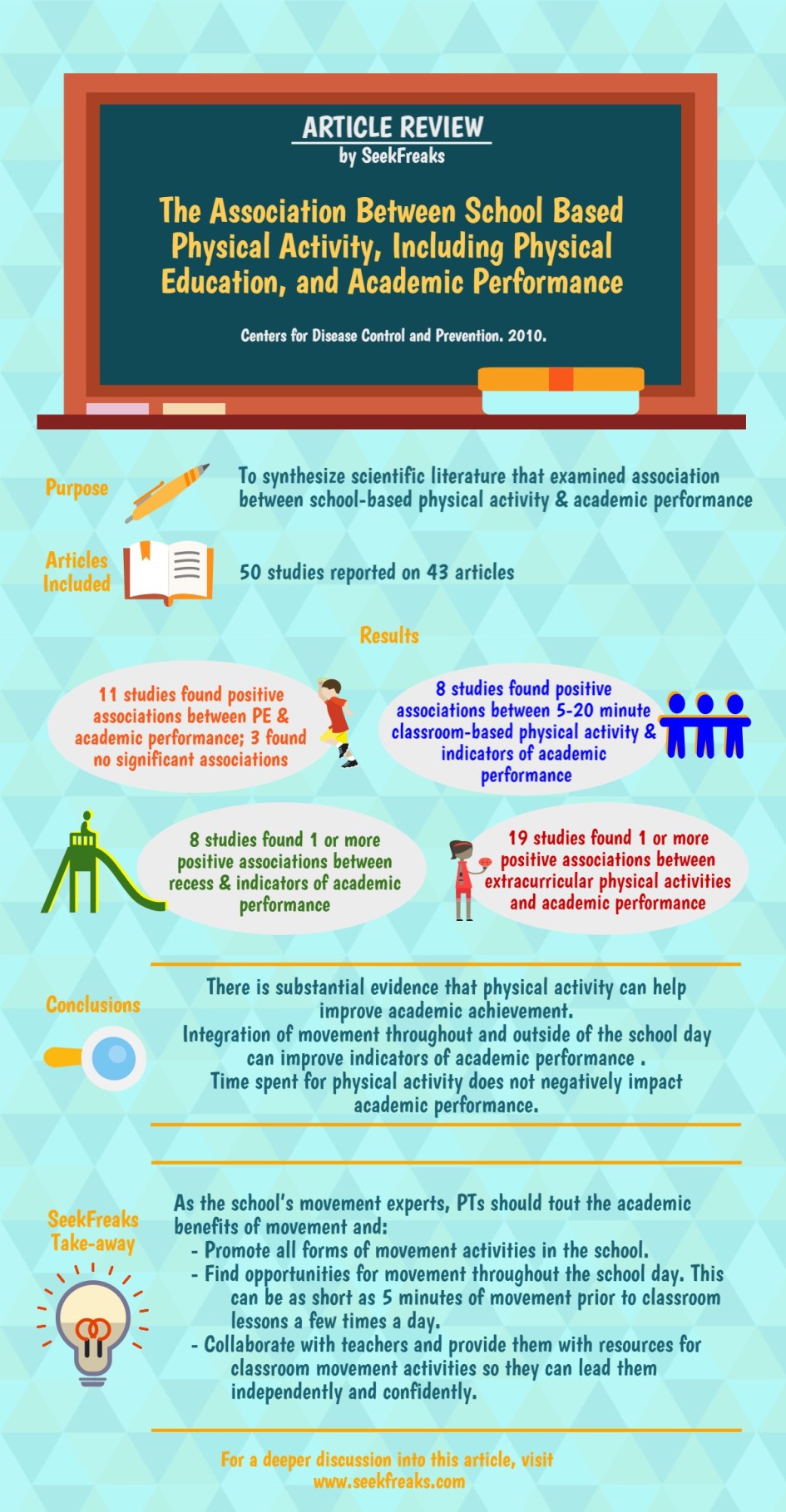[smbtoolbar]
Happy New Year, SeekFreaks!
Fitness has always been at the top of many new year’s resolutions. As school-based practitioners, we should have the same resolution for our students with disabilities, and help make it happen. So, we start the year by providing resources and discussions on increasing opportunities for physical activity in our schools.
This CDC study may be 5 years old, but we believe it is of great use for school-based PTs as an advocacy tool for promoting movement throughout the school day. Every school-based PT should be ready to share the knowledge gleaned from this study with teachers, administrators and other school personnel. The study is proof that movement throughout the school day and week promotes learning. It also includes suggestions on how to create opportunities for physical activity.
The study looked at 4 different types of physical activities:
- Physical education
- Recess
- Classroom-based physical activity
- Extracurricular physical activities
Their Findings
Physical Education
- PE intervention studies found 1 or more positive associations with academic skills and attitudes:
- 10 studies found – ↑ achievement test scores
- 3 studies each found – ↑ attention or concentration; ↑ perception of academic or intellectual competence
- 2 studies each found – impulse control; improved conduct
- 1 study each found – ↑ self-esteem; ↑ creativity; ↑ perceived self-concept; ↑ life satisfaction; ↑ grade
- There was no reported negative relationship between increased time for PE and academic achievement.
Recess
- Recess intervention studies found one or more positive associations with academic skills & attitudes
- 4 studies found – ↑ attention and concentration
- 4 studies found – improved on-task behavior (↓ fidgeting)
- At least 15 minutes of recess improved classroom behavior
Classroom-based Physical Activity
- Classroom-based physical activity intervention studies found positive associations with academic skills and attitudes:
- 5 studies found – ↑ achievement test scores
- 1 study each found – ↑ attention or concentration; ↑ visual/spatial skills; improved classroom behavior
- Activities lasted 5-20 minutes per session, delivered on a daily or regular basis.
- There was no reported negative relationship between time for classroom physical activity and academic achievement.
Extracurricular Physical Activities
- Extracurricular physical activity intervention studies found positive associations with academic skills and attitudes:
- 6 studies found – ↑ self-esteem/self-concept
- 3 studies found – ↑ motor ability
- 1 study each found – ↑ working memory; ↑ attendance; ↑ grade point average
- Extracurricular physical activity non-intervention studies found 28 more positive associations with academic skills and attitudes, including 11 that found ↑ grade point average.
- Activities included sports or exercises.
- 2 studies found participation in extracurricular physical activity ↓ high school dropout rates.
PT and Academics
School-based PTs who are struggling to find a clear connection between PT and academics need look no further: academic performance is enhanced by movement, and PTs are experts in movement! Teachers can more readily buy into a movement program if they know that it will help improve their student’s academic performance. They will also find it helpful that students’ classroom behavior is likely to improve. Physical activities may make students less fidgety and more attentive.
A frequent concern of teachers and school administrators is that physical activity will take time away from the students’ learning. They will be pleased to learn that this study found that time spent on physical activities had no adverse effect on the students’ academics.
Students with Disabilities and Movement
Movement opportunities throughout the school day may be even more important for students with disabilities. They engage in less physical activities than their peers with typical development, and, consequently, develop more secondary impairments. (Rowland et al, 2015)
In addition to the academic benefits described above, physical activities can also give them opportunities to:
- build their strength and endurance
- practice skilled movement multiple times in a day (e.g., exercises that require maintaining dynamic balance while performing tasks like reaching or bending)
- socialize with their peers in fun and interactive situations
- prevent secondary impairments, such as obesity and its comorbidities
Take-aways
As the school’s movement experts, PTs should tout the academic benefits of movement and:
- Promote all forms of movement activities in the school.
- Find opportunities for movement throughout the school day. This can be as short as 5 minutes of movement prior to classroom lessons a few times a day.
- Collaborate with teachers and provide them with resources for classroom movement activities so they can lead them independently and confidently.
We’ll share some classroom movement resources with you next week. In the meantime, spread the word: movement is good for academic performance!
~~~~~~~~~~ 0 ~~~~~~~~~~
Readers of this article also read:
7 Wheelchair Operation Tests for School-based Therapists
IEP 4.0 – Creating an Intentional Plan of Care
Response to Intervention, Multiple Tier Systems of Support and PT












February 13, 2020 at 7:21 pm
whoah this blog is magnificent i like studying your posts.
Stay up the good work! You recognize, lots of individuals are looking round
for this information, you can aid them greatly.
March 29, 2021 at 10:26 am
This is so nice to have things broken down. Did I miss it our is there some link that leads you to the studies that are noted. I would like to read some of these studies myself. Thank-you the information provided is always great.